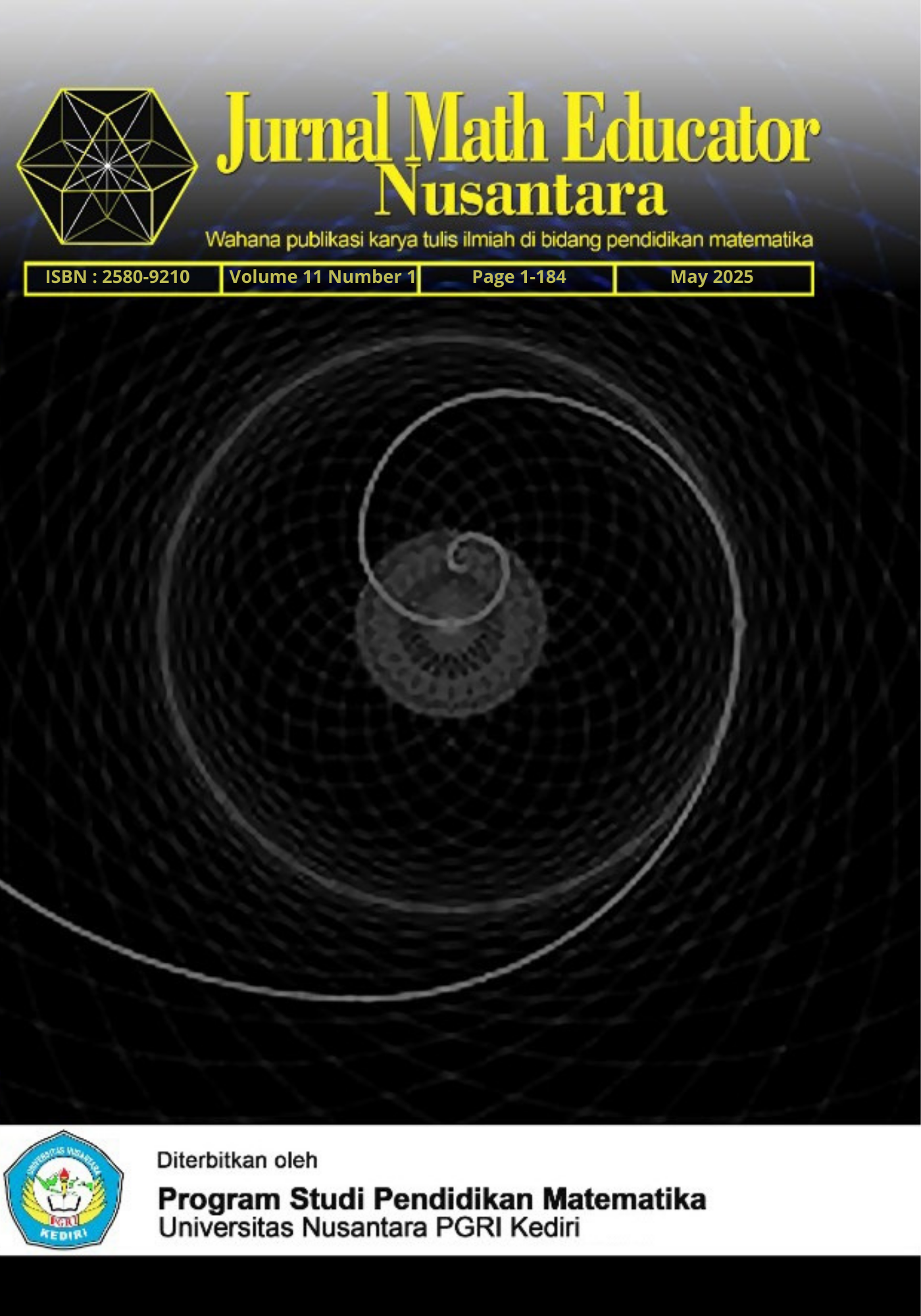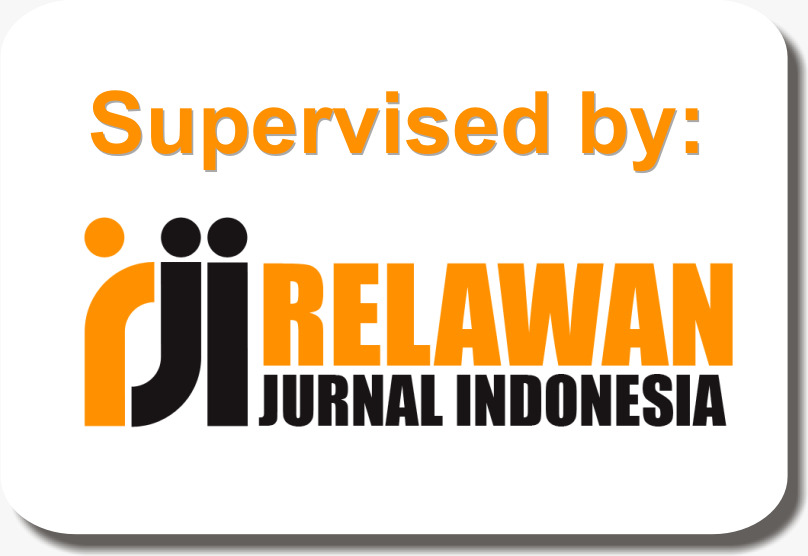Profile of critical thinking ability for prospective elementary school teachers in solving geometry problems based on ethnomathematics
DOI:
https://doi.org/10.29407/jmen.v11i1.24822Keywords:
Critical Thinking, pre-service teacher, elementary school, Geometry, EthnomathematicsAbstract
This study aims to analyze the critical thinking skills of prospective elementary school teachers in solving ethnomathematics-based spatial geometry problems. Critical thinking skills are essential skills for prospective teachers in facing the challenges of modern education. This study uses a descriptive qualitative approach with four final year students of the PGSD Study Program, UN PGRI Kediri as subjects who are classified into two categories, namely high and low ability. Data were collected through problem-solving tests and interviews based on Ennis' critical thinking indicators, which include simple explanations, basic skills, strategies and tactics, conclusions, and further explanations. The results showed that low-ability subjects were only able to achieve three of the five critical thinking indicators, namely providing simple explanations, building basic skills, and drawing conclusions. Meanwhile, high-ability subjects were able to meet all critical thinking indicators. This study confirms that critical thinking skills can be developed through ethnomathematics-based problem presentation, which links mathematical concepts to local culture.
References
Aprillian, T. G., Putra, E. D., & Anas, A. (2023). ANALISIS BERPIKIR KRITIS BERBASIS ETNOMATEMATIKA PADA KONSEP GEOMETRI DALAM PERMAINAN GOBAK SODOR. Prismatika: Jurnal Pendidikan Dan Riset Matematika, 6(1). https://doi.org/10.33503/prismatika.v6i1.3379
Arisoy, B., & Aybek, B. (2021). The effects of subject-based critical thinking education in mathematics on students' critical thinking skills and virtues*. Eurasian Journal of Educational Research, 2021(92). https://doi.org/10.14689/ejer.2021.92.6
Bhakti, Y. B., Arthur, R., & Supriyati, Y. (2023). Development of an assessment instrument for critical thinking skills in Physics: A systematic literature review. Journal of Physics: Conference Series, 2596(1). https://doi.org/10.1088/1742-6596/2596/1/012067
Brown, R. (2023). Teacher perceptions of critical thinking skills within primary school design and technology. https://openjournals.ljmu.ac.uk/DesignTechnologyEducation/article/view/1183
Cici Nur'aini, S., Primasatya, N., Nusantara, U., & Kediri, P. (2024). Analisis Kebutuhan Media Congklak Ekspresif Berbasis Etnomatematika Untuk Menumbuhkan Numerasi Siswa Kelas IV. https://ojs.unpkediri.ac.id/index.php/dedikasi/article/view/24254/4309
Creswell, J. W. (2020). Penelitian Kualitatif & Desain Riset : Memilih di Antara Lima Pendekatan. In Mycological Research.
D'Ambrosio, U. (1985). Ethnomathematics and Its Place in the History and Pedagogy of Mathematics. For the Learning of Mathematics.
Dolapcioglu, S., & Doğanay, A. (2022). Development of critical thinking in mathematics classes via authentic learning: an action research. International Journal of Mathematical Education in Science and Technology, 53(6). https://doi.org/10.1080/0020739X.2020.1819573
Dwyer, C. P., & Walsh, A. (2020). An exploratory quantitative case study of critical thinking development through adult distance learning. Educational Technology Research and Development, 68(1). https://doi.org/10.1007/s11423-019-09659-2
Ennis, R. H. (1996a). Book Reviews: Critical Thinking Prentice Hall. Prentice Hall, 40(ue 1)).
Ennis, R. H. (1996b, 1996). The nature of critical thinking: An outline of critical thinking dispositions and abilities Presentation at the Sixth International Conference on Thinking at MIT,
Ennis, R. H. (2011). Critical Thinking: Reflection and Perspective Part I. Inquiry: Critical Thinking across the Disciplines, 26(1).
Fitriani, D., & Putra, A. (2022). Systematic Literature Review (SLR): Eksplorasi Etnomatematika pada Makanan Tradisional. Journal of Mathematics Education and Learning, 2(1). https://doi.org/10.19184/jomeal.v2i1.29093
Hasnawati, H., Khair, B. N., & Oktavianti, I. (2021). Analisis Hubungan Keterampilan Berpikir Kritis dengan Kecenderungan Berpikir Kritis Mahasiswa Calon Guru Sekolah Dasar. Jurnal Syntax Transformation, 2(06). https://doi.org/10.46799/jst.v2i6.305
Kamidah, N., Zaenuri, Z., & Junaedi, I. (2023). Development of Teaching Materials Using ProblemBased Learning (PBL) Models with Ethnomathematics Nuances to Improve Students' Critical Thinking Ability. International Journal of Research and Review, 10(8), 228-235. https://doi.org/10.52403/ijrr.20230829
Lombardi, L., Mednick, F. J., Backer, F., & Lombaerts, K. (2022). Teachers' Perceptions of Critical Thinking in Primary Education. International Journal of Instruction, 15(4). https://doi.org/10.29333/iji.2022.1541a
Lombardi, L., Thomas, V., Rodeyns, J., Mednick, F. J., Backer, F., & Lombaerts, K. (2024). Primary school teachers' experiences of teaching strategies that promote pupils' critical thinking. Educational Studies, 50(5). https://doi.org/10.1080/03055698.2021.1990017
Maknun, J. (2020). Implementation of Guided Inquiry Learning Model to Improve Understanding Physics Concepts and Critical Thinking Skill of Vocational High School Students. International Education Studies, 13(6). https://doi.org/10.5539/ies.v13n6p117
Musser, G. L., Peterson, B. E., & Burger, W. F. (2013). National Council of Teachers of Mathematics Principles and Standards for School Mathematics Principles for School Mathematics.
Primasatya, N., & Imron, I. F. (2020). Analysis of student needs of the mathematics club (MC) as a co-curricular activities as an effort to grow up 4C skills. Jurnal Math Educator Nusantara, 6(2), 215–223. http://repository.polnep.ac.id/xmlui/bitstream/handle/123456789/354/03-YANI
Risdiyanti, I., & Sulisworo, D. (2021). Developing Student Book Based on Ethnomathematics to Improve Studentâ€TMs Critical Thinking Skill. JIML) JOURNAL OF INNOVATIVE MATHEMATICS LEARNING, 4(1). https://doi.org/10.22460/jiml.v4i1.p1-11
Schack, E. O., Fisher, M. H., Thomas, J. N., Eisenhardt, S., Tassell, J., & Yoder, M. (2013). Prospective elementary school teachers' professional noticing of children's early numeracy. Journal of Mathematics Teacher Education. https://doi.org/10.1007/s10857-013-9240-9
Suharyani, L. A., Nugroho, A. S., & Dewi, E. R. S. (2023). Profil keterampilan berpikir kritis siswa SMA pada materi perubahan lingkungan berbasis strategi metakognitif. Practice of The Science of Teaching Journal: Jurnal Praktisi Pendidikan, 2(1). https://doi.org/10.58362/hafecspost.v2i1.30
Suryawan, I. P. P., Jana, P., Pujawan, I. G. N., Hartawan, I. G. N. Y., & Putri, P. E. W. (2023). Ethnomathematically Controversial Problem-Based Multimodal Approach in Terms of Students' Critical Thinking Ability. Pegem Journal of Education and Instruction, 13(ue 3)).
Tasgin, A., & Dilek, C. (2023). The mediating role of critical thinking dispositions between secondary school student's self-efficacy and problem-solving skills. Thinking Skills and Creativity, 50. https://doi.org/10.1016/j.tsc.2023.101400
Downloads
Published
Issue
Section
License
Copyright (c) 2025 Nurita Primasatya, Ilmawati Fahmi Imron, Erwin Putera Permana

This work is licensed under a Creative Commons Attribution 4.0 International License.
Authors who publish with this journal agree to the following terms:
- Copyright on any article is retained by the author(s).
- The author grants the journal, the right of first publication with the work simultaneously licensed under a Creative Commons Attribution License that allows others to share the work with an acknowledgment of the work’s authorship and initial publication in this journal.
- Authors are able to enter into separate, additional contractual arrangements for the non-exclusive distribution of the journal’s published version of the work (e.g., post it to an institutional repository or publish it in a book), with an acknowledgment of its initial publication in this journal.
- Authors are permitted and encouraged to post their work online (e.g., in institutional repositories or on their website) prior to and during the submission process, as it can lead to productive exchanges, as well as earlier and greater citation of published work.
- The article and any associated published material is distributed under the Creative Commons Attribution-ShareAlike 4.0 International License
















